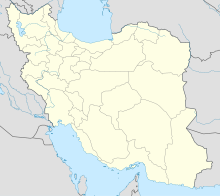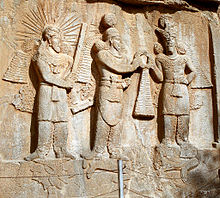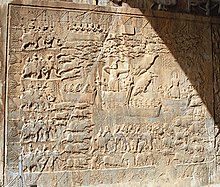Taq-e Bostan
Coordinates: 34 ° 23 '15.1 " N , 47 ° 7' 55.5" E
Tāq-e Bostān or Taqwasân or Taq-i-Bustan ( Persian طاق بستان, Kurdish : Taqwesan ) is a place with a series of large rock reliefs from the era of the Sassanid Empire , which existed from 226 to 650. The complex, which can be translated as “garden arch” (from Persian bustān ), which was once in a paradeisos , is located 5 km northeast of the city of Kermānschāh in western Iran in the middle of the Zāgros Mountains and belonged to the historical region of Media .
The reliefs are some of the finest and best preserved examples of Sassanid art and include scenes from the investiture of Ardashir II , Shapur III. and Chosrau II. Like other Sassanid works, Tāq-e Bostān emphasizes with his pictures the power, religious tendencies, fame, honor, the size of the royal court, the fighting and game spirit, festivities, joy and jubilation.
The Sassanid kings chose a beautiful setting for the reliefs along a rest area on the historic Silk Road . The reliefs lie next to a sacred spring that flows into a basin at the foot of a cliff.
Tāq-e Bostān with its reliefs is one of 30 relics of the Sassanids in the Zāgros Mountains. According to Arthur Pope, the founder of the Iranian Art and Archeology Institute of the United States, art was characteristic of the Iranian people and a gift they made to all of humanity.
Description of the works
Tāq-e Bostān consists of a large and a small hall carved into the rock with arched ceilings - the so-called iwans - and a large relief. They illustrate the coronation ceremonies of Ardashir II and Shapur III. They also show hunting scenes by Chosrau II.
The coronation ceremony of Ardashir II.
The first Tāq-e Bostān relief, and apparently the oldest, is a stone relief of the coronation ceremony of Ardashir II. It consists of four people with swords, helmets and the lotus , which was cultivated by the Iranians. The work is 4.07 m wide and 3.90 m high.
Looking closer you can see how detailed the artists worked. The figure on the right wears a jagged crown. She has turned to the figure in the middle and is holding out a royal ring. The middle figure is wearing a helmet. Both figures wear robes that cover their bodies up to their knees. The robes are different because the hem of the robe of the middle figure is round. Her helmet is round and allows the hair to hang down underneath. On the left is a figure with a bill around his head and a sword in his hand. Their feet are noticeably smaller than those of the others. She wears delicate and elegant shoes. Her small heels rest on a lotus, which shows the artist's intention to create a soft and delicate surface for the delicate shoes.
The whole scene can now be described as follows: Ardaschir II. In the middle receives the ring as a symbol of royal power from the god Ahura Mazda . Behind Ardaschir II stands Mithras , who protected Ardaschir II in his deeds with a sword. Mithras was previously the patron god of the Parthian military. The reclining figure under Ardashir II is a defeated Roman, possibly the Emperor Julian .
According to another interpretation, the recumbent figure is Haftanbokht from Karnamak-i Ardaschir and the right figure is Kayu from Kermanshah, who was reinstated as local ruler by Ardaschir I (figure in the middle).
The coronation ceremony of Shapur III.
The smaller Ivan contains two Pahlavi inscriptions and engravings of Shapur II or Shapur the Great and his son, Shapur III, looking at each other. The smaller Ivan's room is 6 × 5 × 3.6 m. It is believed that the Ivan during the time of Shapur III. has been built. Some date the completion to the year 385. The Pahlavi inscriptions clearly represent the two figures. The translations are:
The inscription of Shapur II:
This is the figure of Gottesanbeters Shapur, king of Iran and Anirans (non-Iran) ( Eran ud Aneran ), divine race of God. Son of the good worshiper of God Hormizd II , the king of Iran and Anirans (non-Iran), divine family, grandson of Narseh , the Shahinschah.
The inscription of Shapur III:
This is the figure of the praying mantis Shapur, the king of Iran and Anirans (non-Iran), divine sex of God. Son of the good worshiper of God Shapur II , the king of Iran and Anirans (non-Iran), divine family.
The figures of the two kings are about 3 m tall. Shapur II stands on the right and Shapur III. Left. Both hold a long sword pointing down in their hands. The right hand rests on the pommel and the left rests on the handle. Both figures wear loose pants, necklaces, curly hair and a goatee.
The coronation ceremony of Chosraus II.
The back wall of the large ivan is divided into two parts. Above is a picture of the coronation ceremony of Chosraus II. (591–628) and below Chosrau II. As a rider.
The ceremony shows Chosrau II in the middle, flanked by Ahura Mazda on the left and Anahita on the right. Both gods hold on to rings. The king receives one of the royal rings.
One of the most impressive reliefs within the great ivan is the gigantic equestrian figure of King Chosraus II on his favorite warhorse Shabdiz. Both are shown in full armor. The equestrian image is 7.45 m wide and 4.25 m high.
The outer part of the ivan is decorated with tree reliefs and angels. The tree symbolizes the tree of life or the sacred tree.
Boar and deer hunting scene
There are two hunting scenes on the sidewalls of the ivan. One scene shows the royal boar hunt and the other shows the king hunting deer . From the time of Cyrus II until the end of the Sassanids, hunting was one of the most popular pursuits of the Iranian kings. That is why one often finds images of the hunt alongside those of the coronation ceremonies.
In the boar hunting scene, five elephants scare the boars from a lake while the king waits with a bow and arrow and female singers make music for him. In the next scene a boat carries female musicians playing horizontal angle harps, while in the king's boat the leading musician can be seen with a vertical angle harp (Persian chang ). The king, aiming with a bow and arrow, has just killed two large boars. The next boat shows the king standing with a halo around his head and a relaxed bow - a sign that the hunt is over. Below the picture the elephants collect the game and lay it on their backs. The picture is 6 m wide and 4.25 m high. This hunting scene is one of the most vivid images that has ever been immortalized in stone.
The picture of the deer hunt is 5.9 m wide and 4.35 m high. It shows Chosrau riding at a flying gallop . A military band can be seen here. In the middle field in the upper row on the left there is a musician who probably plays a double reed instrument ( nāy , today surnāy ). The musician to the right could be holding a square frame drum in his hand. The other two musicians may play a mouth organ similar to the Chinese sheng , which in Sassanid times was known in Middle Persian as mustak and later as muschtaq sīnī ("Chinese muschtaq "). The military band on the right, which consists of six musicians in two rows, includes a musician in the upper row of seats who plays a boiler drum ( kūs ), the next blows a straight long trumpet and the third beats one or two small boiler drums ( tasa ) . Of the three standing musicians in the lower row, two play straight long trumpets and the right one an hourglass drum (Middle Persian probably tabīr or tabīra ), which he holds horizontally in front of his stomach.
Qajar Fath Ali Shah
Tāq-e Bostān also contains a work from the time of the Qajars , more than 1,300 years after the Sassanids. You can see the Qajar king Fath Ali Shah holding court. The work is on a side wall of the smaller ivan.
gallery
See also
literature
- 'Alī Akbar Sarfarāz, Bahman Fīrūzmandī: Mād, Hakhāmanishī, Ashkānī, Sāsānī. Jihād-i Dānishgāhī, Tehran 1996, ISBN 964-90495-1-7 (Persian).
- Gardeshgary Magazine. Vol. 13, September 2002, ZDB -ID 2630505-7 .
- Iranian Cultural News Agency (CHN)
Web links
Individual evidence
- ^ Charles A. Reed: Imperial Sassanian Hunting of Pig and Fallow-Deer and Problems of Survival of These Animals Today in Iran. In: Postilla, No. 92. Peabody Museum of Natural History, Yale University, November 5, 1965, pp. 1-23
- ^ Henry George Farmer : The Instruments of Music on the Ṭāq-i Bustān Bas-Reliefs. In: Journal of the Royal Asiatic Society of Great Britain and Ireland, No. 3, July 1938, pp. 397-412
- ^ Henry George Farmer, 1938, pp. 103-105









